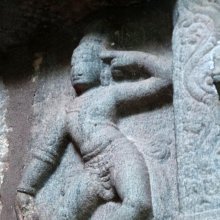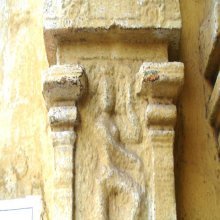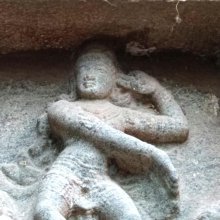Tripataka, Tripatāka, Tri-pataka: 9 definitions
Introduction:
Tripataka means something in Hinduism, Sanskrit. If you want to know the exact meaning, history, etymology or English translation of this term then check out the descriptions on this page. Add your comment or reference to a book if you want to contribute to this summary article.
Images (photo gallery)
In Hinduism
Natyashastra (theatrics and dramaturgy)
Source: Wisdom Library: Nāṭya-śāstraTripatāka (त्रिपताक, “three fingers flag”) refers to a gesture (āṅgika) made with a ‘single hand’ (asaṃyuta), according to the Nāṭyaśāstra chapter 8. The hands (hasta) form a part of the human body which represents one of the six major limbs (aṅga) used in dramatic performance. With these limbs are made the various gestures (āṅgika), which form a part of the histrionic representation (abhinaya).
(Instructions of Tripatāka): The third finger of the Patāka hand to be bent.
(Uses of Tripatāka): It is to be used in representing invocation, descent, bidding goodbye, prohibition, entrance, raising up [anything], bowing [in salutation], comparing, suggesting alternatives, touching [the head with] auspicious objects or putting them on the head, putting on a turban or a crown and covering the mouth or the ears. This very hand with its fingers pointing downwards and moving up and down is to be used in representing flight of small birds, stream, snake, bees and the like. And with the third finger of the Tripatāka should be represented wiping off tears, drawing a Tilaka or Patralekhā and touching of hairs.
Source: archive.org: The mirror of gesture (abhinaya-darpana)One of the Twenty-eight Single Hands (hasta):—Tripatāka (three parts of the flag): the third finger of the Patāka hand is bent. Usage: a crown, tree, vajra weapon, the bearer of the vajra (Indra), screw-pine flower, light, rising flames, cheek, patterns drawn on the face or body (patra-lekhā), arrow, turning roimd, vmion of woman and man.
According to another book: same definition. It is so calledsince Śakra (Indra) and others held the vajra weapon with threeparts of the "flag", leaving out the third finger. Its colour is red, it is of Kṣattriya race, its sage is Guha, its patron deity Śiva. Usage: invocation, descent (avataraṇa) , lifting or bending down the face, touching auspicious things, hook, site (khala), disrespect, doubt, crown, tree, Vāsava (Indra), vajra, stroking the hair, lamp, marking the brow-spot, tying a turban, applying strong scents, closing the nose or ears, rubbing-down a horse, arrow, screw-pine flower, patterns drawn on the face or body, the flight of certain birds, tongues of flame, Kṣattriya caste, red colour.
Note: According to Dhanaṃjaya (“Daśarūpa”, I, 126) the Tripatāka hand is used in stage whispers (janāntika) to shut out the others when only one person is addressed out of several present on the stage, e.g. “Śakuntalā”, vi, 24.
Source: Shodhganga: Elements of Art and Architecture in the Trtiyakhanda of the Visnudharmottarapurana (natya)Tripatāka (त्रिपताक) refers to one of the twenty-two Asaṃyuktahastas or “single hand gestures” (in Indian Dramas), according to the Viṣṇudharmottarapurāṇa, an ancient Sanskrit text which (being encyclopedic in nature) deals with a variety of cultural topics such as arts, architecture, music, grammar and astronomy.—The hasta-mudrās (lit. “hand-gestures”) are very essential to denote some particular action or state in dancing and these mudrās are formed with the help of hands and fingers.—The word tripatāka itself identifies the importance of the number three. According to the Viṣṇudharmottarapurāṇa in tripatāka-hasta, three fingers should be straightened in a patākaēhasta where the ring finger is bent. Abhinavagupta also keeps his view point in the same way. The Viṣṇudharmottarapurāṇa states that this posture is used to denote some activities like calling a person, putting crown on head, wipe off tears, auspicious touch on head, covering of ears, movements of serpent and bees etc.
According to the Abhinayadarpaṇa, the tripatāka hand is used to denote some objects like crown, arrows, tree, the ketakī flower, lamp etc. This hand posture shows the action of writing letters. Indra along with his weapon i.e., vajra, is also shown with this hand posture in Dance.

Natyashastra (नाट्यशास्त्र, nāṭyaśāstra) refers to both the ancient Indian tradition (shastra) of performing arts, (natya—theatrics, drama, dance, music), as well as the name of a Sanskrit work dealing with these subjects. It also teaches the rules for composing Dramatic plays (nataka), construction and performance of Theater, and Poetic works (kavya).
Languages of India and abroad
Sanskrit dictionary
Source: DDSA: The practical Sanskrit-English dictionaryTripatāka (त्रिपताक).—
1) the hand with three fingers stretched out or erect.
2) the forehead marked naturally with three horizontal lines.
Derivable forms: tripatākaḥ (त्रिपताकः).
Tripatāka is a Sanskrit compound consisting of the terms tri and patāka (पताक).
Source: Cologne Digital Sanskrit Dictionaries: Monier-Williams Sanskrit-English Dictionary1) Tripatāka (त्रिपताक):—[=tri-patāka] [from tri] mfn. (with kara, hasta, the hand) with 3 fingers stretched out (in [dramatic language] introductory to words meant janāntikam), [Bālarāmāyaṇa iii, 4/5; Sāhitya-darpaṇa vi, 139; Purāṇa-sarvasva; Hasta-ratnāvalī]
2) [v.s. ...] (kākara), [Daśarūpa]
3) [v.s. ...] (with lalāṭa, the forehead) marked naturally with 3 wrinkles, [cf. Lexicographers, esp. such as amarasiṃha, halāyudha, hemacandra, etc.]
Source: Cologne Digital Sanskrit Dictionaries: Yates Sanskrit-English DictionaryTripatāka (त्रिपताक):—[tri-patāka] (kaḥ) 1. m. The forehead naturally marked with three horizontal lines; the hand with three fingers erect.
[Sanskrit to German]
Sanskrit, also spelled संस्कृतम् (saṃskṛtam), is an ancient language of India commonly seen as the grandmother of the Indo-European language family (even English!). Closely allied with Prakrit and Pali, Sanskrit is more exhaustive in both grammar and terms and has the most extensive collection of literature in the world, greatly surpassing its sister-languages Greek and Latin.
Kannada-English dictionary
Source: Alar: Kannada-English corpusTripatāka (ತ್ರಿಪತಾಕ):—[noun] (dance.) a single-hand gesture, bending the ring-finger, and extending other fingers upward, and bending the thumb as to touch the base of the forefinger, to express touching of auspicious things, calling, disrespect, bidding good-bye, etc.
Kannada is a Dravidian language (as opposed to the Indo-European language family) mainly spoken in the southwestern region of India.
See also (Relevant definitions)
Starts with: Tripatakahasta, Tripatakakara, Tripatakavicara.
Full-text (+27): Kalki, Narasimha, Tripatakakara, Kuruvaka, Rasala, Apavaritaka, Vishnu, Arjuna, Bhagiratha, Ardha-pataka, Dadhi, Shambhu, Kartarimukha, Auspicious touch, Three, Pakshavancitaka, Arrow, Writing, Uttanavancita, Paksha-vancita.
Relevant text
Search found 6 books and stories containing Tripataka, Tripatāka, Tri-pataka, Tri-patāka; (plurals include: Tripatakas, Tripatākas, patakas, patākas). You can also click to the full overview containing English textual excerpts. Below are direct links for the most relevant articles:
Abhinaya-darpana (English) (by Ananda Coomaraswamy)
Chapter 19 - Hands denoting Avatars of Vishnu
Chapter 17 - Hands denoting Devas
Gati in Theory and Practice (by Dr. Sujatha Mohan)
Description of Gati in Abhinayadarpaṇa < [Chapter 2 - Concept and technique of Gati]
Gati performed in Pūrvaraṅga < [Chapter 3 - Application of gati in Dṛśya-kāvyas]
Natyashastra (English) (by Bharata-muni)
Chapter IX - Gestures of Major Limbs (aṅga)
Chapter XXVI - Varied Representation (citrābhinaya)
Vishnudharmottara Purana (Art and Architecture) (by Bhagyashree Sarma)
2.2. Hand Postures (a): Asaṃyukta-hasta < [Chapter 3 - Drama and Dance]
2. The Viṣṇudharmottara-purāṇa and the Indian Classical Dances < [Chapter 6 - Modern Relevance of Different Art Forms and Architecture]
1.3. Elements of Drama (e): Gatiprasāra (gait extension) < [Chapter 3 - Drama and Dance]
The Religion and Philosophy of Tevaram (Thevaram) (by M. A. Dorai Rangaswamy)
Chapter 3.1 - Tripurantaka-murti (burning down of the three castles) < [Volume 2 - Nampi Arurar and Mythology]
Kathakali, and Other Forms of Bharata Natya < [September-October 1933]


